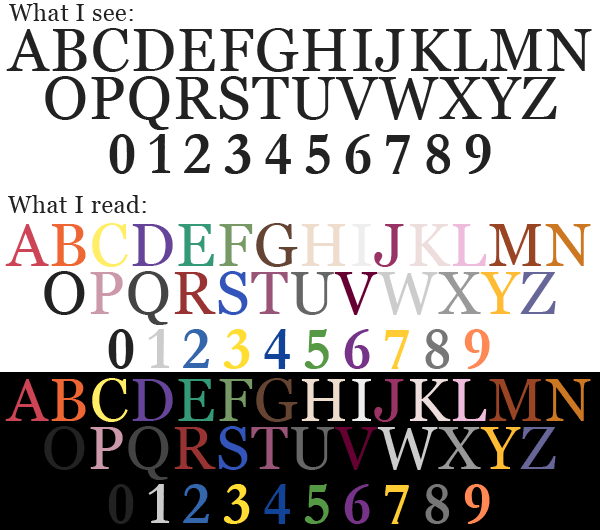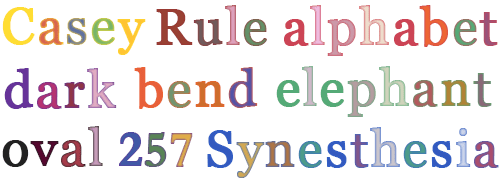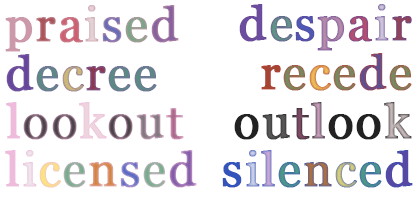Synesthesia
I have a type of synesthesia (or synaesthesia) called grapheme→color synesthesia. Put very simply, that means that I read in color. I have yet to find a particularly clear way to describe this condition accurately to someone who does not experience it (although I've done my best to create an extremely approximate demonstration here.) Honestly, I find the idea of reading without color to be as baffling as others seem to find how I read. I am hoping that by writing it all out I will be able to explain it a little better.
Here is a very approximate representation of the colors I read:

Well, kind of. Actually, it's a little more complicated than that. Have you ever seen this?
Aoccdrnig to rscheearch at Cmabrigde uinervtisy, it deosn't mttaer waht oredr the ltteers in a wrod are, the olny iprmoetnt tihng is taht the frist and lsat ltteres are at the rghit pclae. The rset can be a tatol mses and you can sitll raed it wouthit a porbelm. Tihs is bcuseae we do not raed ervey lteter by it slef but the wrod as a wlohe.
While it is not clear whether or not this study ever actually took place, there is clearly at least some truth to this example, as evidenced by the fact that you can read it. It is evident that when reading, we tend to give the most attention to the first letter of each word. Also, we don't read each letter individually; instead, we look at the collection of letters and interpret them as a single unit. Because of this, it is significnatly easier to overlook a typo when it's at the ebginning of a word. (For example, I suspect that more readers noticed that I misspelled “beginning” than noticed that I misspelled “significantly” in the previous sentence.)

When I read a word, the color of the first letter sort of “tints” the entire word, as shown on the right. This is particularly apparent when looking at anagrams. For example, the word “praised” and the word “despair” are tinted differently, despite having the same letters. The “o” that starts the word “outlook” gives it a generally darker look than the word “lookout,” even though they are made up of the same two words.

I hope that all made sense. If not, don't feel bad. I probably don't really understand how you read either.
Frequently Asked Questions
So, can you see the real color too?
Yes, the colors that I see are completely independent from the colors that I read. I can see that this “A” is black and read that it is red at the same time, just like you can see that a basketball is orange and see that it is round at the same time. I know it doesn't really make sense, but I haven't found a better way to describe it yet.
So do you just constantly see extra colors all over the place?
Do you constantly see letters and numbers all over the place? I'm never entirely sure what people mean by this question, but to be clear, I only see colors when I read something. An “A” isn't red until I read it, just like a circle isn't an “O” until you read it. When I open a page in a book, I don't know what all the colors are all at once, just as you can't read all the letters on a page at once.
Are upper and lower case letters or letters in different fonts the same color?
Yes, because the color of the letter is tied to the meaning, not the shape. For instance, cursive letters or letters in heavily stylized calligraphy are the exact same color as their print equivalents, even though they often have completely different shapes. Color is the bridge in my mind between the various graphemes for a letter and the semantic concept that the letter represents. For this reason, grapheme→color synesthesia is sometimes classified as a type of “ideaesthesia,” because the inducer is semantic rather than sensory. No matter what it looks like, if I read it as “A” that means I'm reading it as red, and so on. Speaking of which…
Do you see music in color?
Yes and no. I don't see sound as color. That is a different type of synesthesia.
I do, however, read written music in color. Written music, like all written languages, is expressed in graphemes. In the case of written music, the grapheme is a note instead of a letter, but my brain still goes through the same process. When I read an “A” on a staff, I still read it as red. Every note on the page is in color, but the color is tied to the letter name (the written concept) not the pitch (the sonic concept,) so, for instance, a C-sharp is a very different color than a D-flat, even though they represent the same pitch in equal temperament.
In addition, a note will be tinted by its accidental; lighter if sharp and darker if flat. And just as the primary color of a word is the color of the first letter, the primary color of a chord is the color of the root.

So, when you see something red, do you, like, read it as an “A” or something?
I get this question all the time. No, it doesn't work in reverse. First of all, the colors for each letter are very specific, so when you point to your t-shirt and ask me what letter it is, chances are it doesn't really match the color for any letter. Also, I don't make a habit of going around trying to read everything. Do you read an “O” every time you see a circle, or read an “I” every time you see a vertical line?
But most importantly, it is not simply that “A” is synonymous with red for me; rather, a very specific shade of red is the bridge in my mind between the various graphemes for “A” and the semantic concept that “A” represents. If I'm not trying to interpret some sort of grapheme, the bridge isn't used.
Are you just making this up?
No.
Doesn't that make it harder to read?
I have no idea. I have nothing to compare it to, as I don't know any other way to read. I suppose I'm not a particularly fast reader and generally prefer to listen to podcasts and audiobooks as a result, but I don't know if that's necessarily related.
So if I write everything out in the wrong colors, will you still be able to read it?
Yes, I can still read something even if someone colors the letters wrong. Again, the colors that I see are completely independent from the colors that I read. I do find lots of extra colors a little distracting though. (That's one of the reasons I never used highlighters for taking notes.) So, if you take the time to incorrectly color each individual letter of an email, (yes, this has actually happened,) my brain is not going to be completely baffled by all the contradicting colors, as you probably hoped it would. I'm just going to be annoyed.
Isn't synesthesia what happens when you do too many psychedelic drugs?
Unless someone has been spiking my water for as long as I could read, I don't think that's what's going on here. There are cases of what is called “adventitious synesthesia,” in which temporary synesthesia is brought about by drugs or a stroke. I, on the other hand, have what is called “congenital synesthesia*“* (which sounds much more life threatening than it actually is.)
Are the colors the same for all synesthetes?
No, each person with grapheme→color synesthesia has their own set of colors. However, I have read that there are some patterns. For instance, “A” is often red, “B” is often blue, and “I” and “O” are often black or white or one each.
When did you find out you had this?
For a long time, I didn't realize this was something unusual. I've never read any other way so it didn't occur to me that it might not be normal. One day in eighth grade, it occurred to me that my particular colors seems rather arbitrary, and maybe other people see different colors when they read. After asking a few friends what colors their letters were, I realized for the first time that I was seeing something weird.
If you'd like to find out a little more about the science behind all this, here is a nice brief summary: